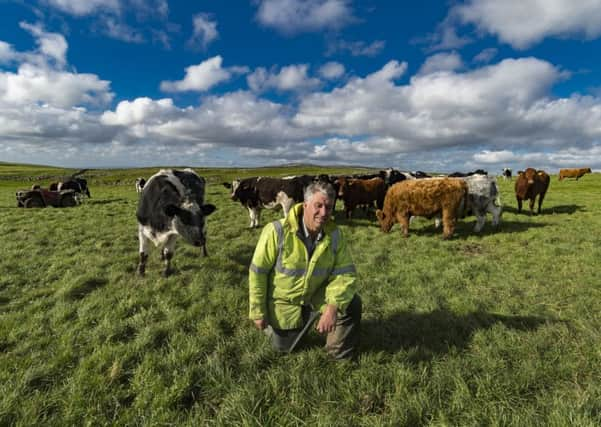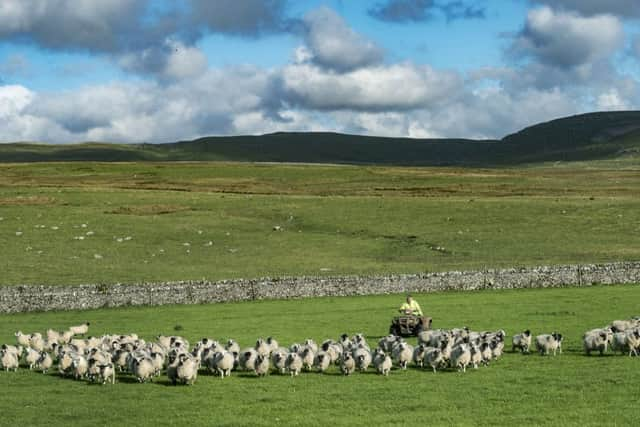Farm of the Week: Frank Carr's Lee Gate Farm, Malham


Beef and sheep man Frank Carr’s Lee Gate Farm, that he runs with brother Norman and his brother’s wife Christine might well have its location marked as Malham but in reality it is a good two to three miles away from civilisation passing tranquil camp sites and featuring a long and winding road up into the hills of Gordale Scar where a couple of miles can take a good 10-15 minutes in summer but in January will be nigh on impassable.
Another surprise is what you find at Lee Gate. This isn’t some small-scale humdrum sheep farm up in the wilds where the likes of Hannah Hauxwell (I know she didn’t live around here) may have eked out a living with no electricity. It’s a large-scale affair with huge cattle sheds where the Carrs specialise in traditional native breeds of cattle and sheep.
Advertisement
Hide AdAdvertisement
Hide AdAmazingly, given its location, this was once home to a large dairy cow herd that also had hundreds of cattle. It was packed with calves, bulls, heifers and the family reared a lot of replacements. The land doesn’t go below 1,200ft above sea level and rises to 1,800ft; transportation for tankers and the expense of getting to and from here must have been self-defeating.


“Back in the 70s Norman and I set up a process of buildings and land improvement and continually increased animal numbers,” says Frank.
“But the events of 2001 (Foot & Mouth Disease year) completely changed everything. Until then we had always milked cows as most farms had. My grandfather Henry Carr moved here in 1927 and we still trade as H. Carr & Son. He used to take the milk down to Bell Busk railway station and send it on the train to the dairy in Leeds.
“We were much the same as others but over the years most changed to beef and sheep. We had kept on with the dairy herd and when Foot & Mouth came along we were milking 300 cows. It’s not an ideal area for them given how high up we are and we relied on purchased feed a great deal.
Advertisement
Hide AdAdvertisement
Hide Ad“All of our stock was completely taken out in 2001 as a contiguous cull. Our staff found new jobs and we eventually returned with livestock farming through fattening cattle and breeding sheep. We then moved from fattening cattle to breeding cows and now keep suckler cows of our own and their offspring rather than buying cattle in.”


Lee Gate runs to nearly 2,000 acres that is all down to grass or rough land with most in the Malham-Arncliffe Site of Special Scientific Interest (SSSI) and a Special Area of Conservation (SAC). The whole farm is in stewardship schemes with 1,000 acres in higher level upland schemes. There is a further 250 acres at Norton View Farm near Hetton several miles away where Frank lives, and the family also rent additional acreages.
“We have kept traditional native breeds ever since we restocked, but we also have continentals. Natural England closely monitors our SSSI and there are incentives for stocking native breeds. We currently have around 60-70 Highland cows, 40 Shorthorn X and quite a number of Hereford, Hereford X and Longhorns. We run all of our own purchased pedigree native breed bulls and have two Herefords and three Shorthorns.
“There is a growing outlet for native breed cattle and we have some good contracts but we stick to the minimum figure that’s required for Natural England regulations because the cattle are slower growing and not as valuable in the mainstream commercial trade. That’s the reason why we also have continentals. Limousins and Belgian Blues are still in demand in supermarkets and we also have our own purchased bulls for these, but Morrisons now have a scheme for Shorthorns and a lot of ours go into their premium beef range. Herefords attract a good premium through Dunbia into the Co-op.”
Advertisement
Hide AdAdvertisement
Hide AdMost of the cattle Frank sells go direct to specialist outlets.
“We sell a few through Gisburn Auction Mart where I’m a director but I try to match what our specialist buyers want such as Gordon Atkinson’s Elite Meats in Starbeck, Harrogate. He’s been having Highland and Highland X from us for much of the past decade. I also sell to Swaledale Meats, Dales Butchers in Kirkby Lonsdale and have recently started with the online company Farmison. Keeping native breeds means that you need the right outlets and I’m constantly looking at who will be a right fit for us.”
The sheep numbers are nowhere near what they used to be at Lee Gate, but there’s been a recent shift in emphasis.
“We now have around 700 Mule ewes, which are largely kept on the better land, and 700-800 horned ewes of mostly Swaledale but also Dalesbred. We’ve just started using a Teeswater tup again to get the Masham lamb. It’s what we used to do 40 years since. Whether it will prove financially rewarding I’m not sure as the Masham lamb has not been fashionable to sell at market but the Masham is arguably better than a Mule carcase.”
Advertisement
Hide AdAdvertisement
Hide AdFrank, while farming in the hills, is by no means a man in the middle of nowhere. He is the longest serving director at Gisburn Auction Mart; a director of ACT (Agricultural Central Trading) that sees him in London once every six weeks and he has his own view on the future of the UK given the Brexit vote.
“I thought it was time for a change and with it there will be new opportunities as there always are. It has certainly helped with the sale price of sheep so far.”
Frank has three offspring – Harriet, Frank and Jack.